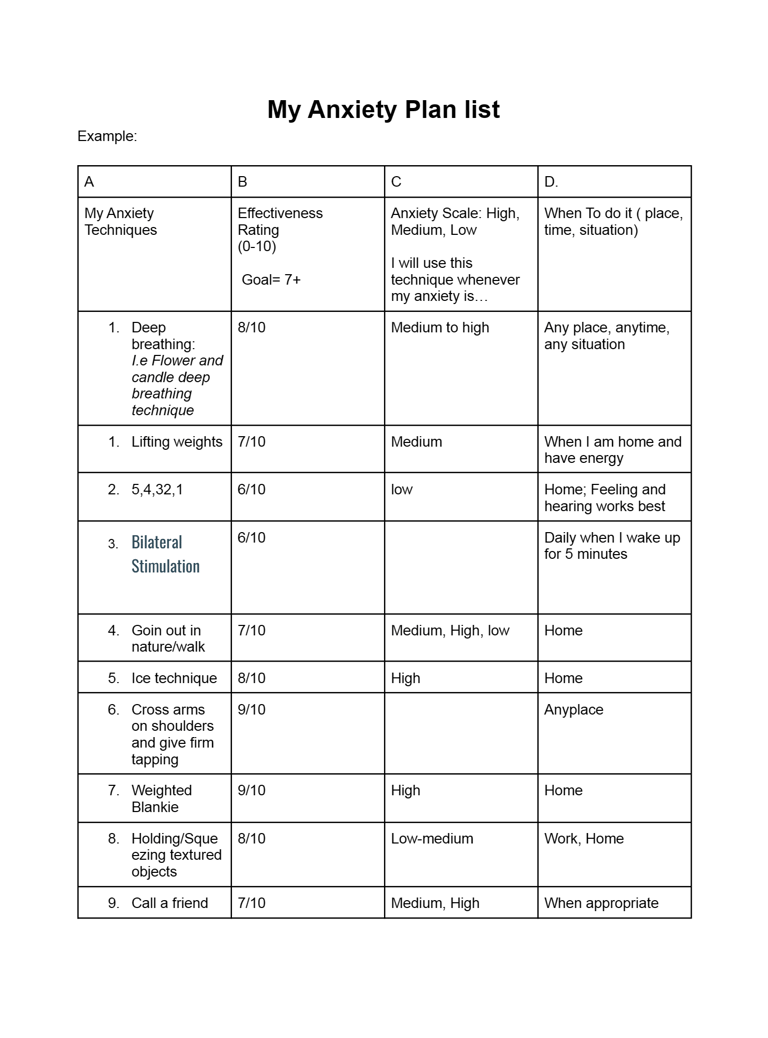"6 Steps to Tame Anxiety: Your Personal Anxiety Action Plan"
A Personalized anxiety plan for when you are anxious + Worksheet Template
MENTAL HEALTH TOOLSANXIETY


Introduction:
Dealing with anxiety can be challenging, but having a well-defined plan in place can make all the difference. When you're feeling anxious, it's essential to have a set of go-to strategies that help you regain control and find calmness. In this article, we'll walk you through a six-step anxiety action plan that can empower you to manage your anxiety effectively.
Step 1: Stop + Breathe + 5,4,3,2,1 Method
When anxiety starts to creep in, the first step is to pause. Stop whatever you're doing and take a deep breath. The 5,4,3,2,1 method is a grounding technique that can help bring your focus back to the present moment. Name five things you can see, four things you can touch, three things you can hear, two things you can smell, and one thing you can taste. This sensory exercise can help redirect your mind away from anxious thoughts.
Step 2: Distract Yourself
Sometimes, the best way to combat anxiety is to engage in activities that make you feel better than you currently do. These activities can vary from person to person, but they should be healthy and enjoyable. Whether it's going for a walk, reading a book, practicing a hobby, or even doing some light exercise, distracting yourself can provide much-needed relief.
Step 3: Visualize the Best Case Scenario
Anxiety often leads us to imagine worst-case scenarios. To counter this, take a moment to visualize the best possible outcome instead. Picture yourself successfully navigating the situation that's causing you anxiety. Visualization can help reframe your perspective and boost your confidence.
Step 4: Challenge Your Thoughts
Anxiety often thrives on irrational or exaggerated thoughts. Challenge these thoughts by seeking evidence that contradicts your fears. Ask yourself, "Is there any concrete evidence to support my anxious thoughts?" More often than not, you'll find that your anxiety is based on assumptions rather than facts.
Step 5: Use Mantras of Positive Affirmations
Positive affirmations can be incredibly powerful in combatting negative self-talk. Create a list of affirmations that resonate with you and make you feel empowered. You can even place them on your bathroom mirror, so you see them daily. When anxiety strikes, recite these affirmations to remind yourself of your strength and resilience.
Step 6: Refer to Your Therapy Notebook or CBT App
If all else fails, don't hesitate to turn to your therapy notebook or a CBT (Cognitive Behavioral Therapy) app. These resources can provide you with structured exercises and strategies to manage your anxiety. Your therapy notebook may contain insights and coping mechanisms you've learned during therapy sessions, making it a valuable resource.
Conclusion:
Having a personalized anxiety action plan like the one outlined above can be a game-changer in your journey to managing anxiety. Remember that everyone's anxiety is unique, so adapt these steps to suit your individual needs and preferences. Over time, you'll become more skilled at recognizing and addressing your anxiety, ultimately finding greater peace and control in your life.
Anxiety Plan Template
Instruction:
Every time you have anxiety, go through the list and depending on the intensity of the anxiety, select the technique that has the highest effectiveness and do them for the duration of time you have indicated.
How to fill out this table:
Column A: Fill out column A based on the anxiety techniques you’ve learnt thus far or you currently use.
Column B: Give an effectiveness rating based on your experience using it from 0 to 10. With 10 = most effective and 0 = not effective at all
Column C: not all tools will be effective at all times. Some tools are more suitable when your anxiety is low, others work better when your anxiety is high ( at its peak). Based on your experience, complete column C. If you don’t have information about this yet, leave it blank and experiment with the anxiety technique until you are able to get a good evaluation.
Column D: Write down the ideal place, time, or situation that you feel would be best to try the technique. Not all techniques ( i.e lifting weights) can be done at work, for example. But breathing techniques can be done anyplace and anywhere.


